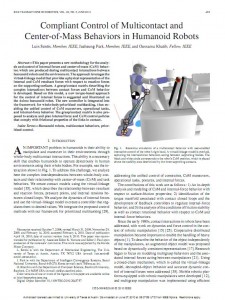Master’s Project: Tricky, Force Controlled Holonomic Base
Master’s students, Somudro Gupta (demonstrator) and Pius Wong (video) show their work on design and control of our new holonomic base Tricky. Tricky employs omni wheels set in a triangular configuration to achieve omni-directional force control. It uses three Maxon motors rated at 250W with 3 stage planetary gears and 60 gear ratio providing 18Nm of torque per wheel. To control the torques, we have developed a new amplifier board capable of doing both current and load cell feedback. The board uses a Freescale 8-bit MC9S08MP16 microcontroller to achieve servo rates of 4KHz. The movie shows force interactions between the base and a user, based on servoing torque feedback.
Spotlight on the multi-contact/grasp matrix for the control of compliant legged robots
The HCRL Lab hosts Marc Raibert
Dreamer says hello to Willow Garage
These sketches present our current progress in compliant control of humanoid robots at Willow Garage. The idea is to combine torque-based compliant behaviors for Cartesian and joint space tasks. This approach enables to respond quickly to contact, be safe and use effectively the dynamics of the mechanism. The focus of this research is more on the skill than on the single low level control process. We provide infrastructure to bridge the gap between the skill developer (who cares about the mathematics of movement and robot dynamics) and the skill user (who cares about motion / high level planning and perception).
The DREAMER Meka-HCRL Sociable Head Arrives to the Lab
Experiments on prioritized compliant control
This video shows various experiments of the control of UT Austin’s humanoid Meka robot. We demonstrate prioritized torque control strategies, addressing hand position tasks and dynamically compensated posture optimization. In particular, the main contribution of the experiments is the ability to optimize posture performance by dynamically compensating the postural mass matrix with the task’s null space matrix.
Compliant Control Experiments on the Meka Robot
Collaborative implementation of compliant control with Stanford Univ. and Willow Garage. Three experiments are shown: (a) gravity effort compensation to validate the robot’s dynamic and kinematic model, (b) dynamically weighted posture control to demonstrate the validity of the mass/inertia matrix, and (c) operational space compliant control in the vertical and Sagittal directions to demostrate the ability to respond to the environment using the tool.



